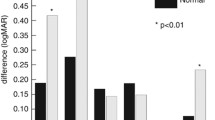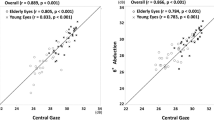Abstract
Purpose
To estimate objective visual acuity in subjects suffering from cataract and age-related macular degeneration via the optokinetic response evoked by a non-conventional induction method (oktotype); in addition, to compare such objective outcome with the subjective acuity based on the ETDRS charts.
Methods
Patients were presented with 13 sequences of symbols arranged horizontally to form a serial pattern, moving from left to right at a constant rate. In each sequence, the size of the stimuli was reduced progressively, while the operator checked for the disappearance of the optokinetic response via a small video camera mounted on the test lens frame. The minimum angular size of the serial pattern able to evoke the optokinetic response (MAER) was referred to as the objective visual acuity of the subject.
Results
Correlation between logMAER and logMAR was significant in the cataract and macular degeneration group (\(R_{\text{cat}}^{2}\) = 0.70, p < .0001; \(R_{\text{AMD}}^{2}\) = 0.63, p < .0007). In the two samples, the correspondence between subjective and objective visual acuity (as, respectively, decimal units and arbitrary decimal units) was satisfactory (concordance correlation coefficient: cataract group = 0.91 and AMD group = 0.93). Test–retest reliability of the oktotype was good for the cataract group and moderate for the AMD sample (Κ 0.81 and 0.59, respectively).
Conclusion
The oktotype seems a promising tool to objectively assess visual acuity in noncooperating subjects with cataract or macular degeneration. Further research on other clinical conditions is needed to clarify the suitability of the procedure in the clinical setting.





Similar content being viewed by others
Notes
We are grateful to the anonymous reviewer for this valuable suggestion.
References
Teller DY (1979) The forced-choice preferential looking procedure: a psychophysical technique for use with human infants. Infant Behav Dev 2:135–153
McDonald MA, Dobson V, Sebris L, Baitch L, Varber D, Teller DY (1985) The acuity card procedure: a rapid test of infant acuity. Invest Ophthalmol Vis Sci 26:1158–1162
McDonald M, Sebris SL, Mohn G, Teller DY, Dobson V (1986) Monocular acuity in normal infants: the acuity card procedure. Am J Optom Physiol Opt 63:127–134
Courage ML, Adams RJ (1990) Visual acuity assessment from birth to three years using the acuity card procedure: cross-sectional and longitudinal samples. Optom Vis Sci 67:713–718
Fielder AR, Dobson V, Moseley MJ, Mayer DL (1992) Preferential looking-clinical lessons. Ophthalmic Paediatr Genet 13:101–110
Tyler CW, Apkarian P, Levi DM, Nakayama K (1979) Rapid assessment of visual function: an electronic sweep technique for the pattern visual evoked potential. Invest Ophthalmol Vis Sci 18:703–713
Bach M, Maurer JP, Wolf ME (2008) Visual evoked potential-based acuity assessment in normal vision, artificially degraded vision, and in patients. Br J Ophthalmol 92:396–403
Steele M, Seiple WH, Carr RE, Klug R (1989) The clinical utility of visual-evoked potential acuity testing. Am J Ophthalmol 108:572–577
Jeon J, Oh S, Kyung S (2012) Assessment of visual disability using visual evoked potentials. BMC Ophthalmol 12:36
Quinn GE, Berlin JA, James M (1993) The Teller acuity card procedure. Three testers in a clinical setting. Ophthalmology 100:488–494
Millodot M, Harper P (1969) Measure of visual acuity by means of eye movements. Optom Vis Sci 46:938–944
Kim MS, Choi YS, Lu WN, Lee K, Hwang GM, Wee WR, Lee JH (2000) The development of an objective test for visual acuity assessment using optokinetic nystagmus stimuli presented head-mounted display: Sreohan objective visual acuity test. J Korean Ophthalmol Soc 41:871–878
Shin YJ, Park KH, Hwang JM, Wee WR, Lee JH, Lee IB (2006) Objective measurement of visual acuity by optokinetic response determination in patients with ocular diseases. Am J Ophthalmol 141:327–332
Wester ST, Rizzo JF, Balkwill MD, Wall C (2007) Optokinetic nystagmus as a measure of visual function in severely visually impaired patients. Invest Ophthalmol Vis Sci 48:4542–4548
Hyon JY, Yeo HE, Seo JM, Lee IB, Lee JH, Hwang JM (2010) Objective measurement of distance visual acuity determined by computerized optokinetic nystagmus test. Invest Ophthalmol Vis Sci 51:752–755
Han SB, Yang HK, Hyon JY, Seo J, Lee JH, Lee IB, Hwang J (2011) Efficacy of a computerized optokinetic nystagmus test in prediction of visual acuity of better than 20/200. Invest Ophthalmol Vis Sci 52:7492–7497
Han SB, Han ER, Hyon JY, Seo JM, Lee JH, Hwang JM (2011) Measurement of distance objective visual acuity with the computerized optokinetic nystagmus test in patients with ocular diseases. Graefes Arch Clin Exp Ophthalmol 249:1379–1385
Millodot M, Miller D, Jernigan ME (1973) Evaluation of an objective acuity device. Arch Ophthalmol 90:449–452
Khan SG, Chen KF, Frenkel M (1976) Subjective and objective visual acuity testing techniques. Arch Ophthalmol 94:2086–2091
Aleci C, Scaparrotti M, Fulgori S, Canavese L (2017) A novel and cheap method to correlate subjective and objective visual acuity by using the optokinetic response. Int Ophthalmol. https://doi.org/10.10007/s10792-017-0709-x
Altman DG (1991) Practical statistics for medical research. Chapman and Hall, London, p 1991
Shrout PE, Fleiss JL (1979) Intraclass correlations: uses in assessing rater reliability. Psychol Bull 86:420–428
Gorman JJ, Cogan DG, Gellis SS (1957) An apparatus for grading the visual acuity of infants on the basis of optokinetic nystagmus. Pediatrics 19:1088–1092
Geer I, Robertson KM (1993) Measurement of central and peripheral dynamic visual acuity thresholds during ocular pursuit of a moving target. Optom Vis Sci 70:552–560
Abadi RV, Pascal E (1991) The effects of simultaneous central and peripheral field motion on the optokinetic response. Vis Res 31:2219–2225
Miyoshi T (1984) Role of the central and peripheral retina upon optokinetic nystagmus: foveal and peripheral nystagmus. Acta Otolaryng Suppl 419:53–61
Ludvigh E, Miller JW (1953) A study of dynamic visual acuity. U.S. Naval School of Aviation Medicine. Research Report No. NM 001 075.01.01
Towle VL, Harter MR (1977) Objective determination of human visual acuity: pattern evoked potentials. Invest Ophthalmol Vis Sci 16:1073–1076
Author information
Authors and Affiliations
Corresponding author
Ethics declarations
Conflict of interest
All authors certify that they have no conflict of interest.
Ethical approval
All procedures performed in studies involving human participants were in accordance with the ethical standards of the institutional and/or national research committee and with the 1964 Helsinki Declaration and its later amendments or comparable ethical standards.
Informed consent
Informed consent was obtained from all individual participants included in the study.
Rights and permissions
About this article
Cite this article
Aleci, C., Cossu, G., Belcastro, E. et al. The optokinetic response is effective to assess objective visual acuity in patients with cataract and age-related macular degeneration. Int Ophthalmol 39, 1783–1792 (2019). https://doi.org/10.1007/s10792-018-1001-4
Received:
Accepted:
Published:
Issue Date:
DOI: https://doi.org/10.1007/s10792-018-1001-4




